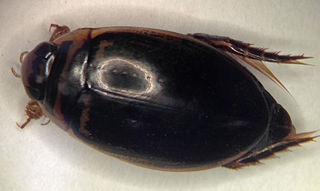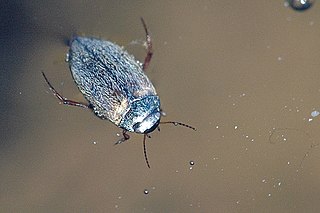
The Dytiscidae – based on the Greek dytikos (δυτικός), "able to dive" – are the predaceous diving beetles, a family of water beetles. They occur in virtually any freshwater habitat around the world, but a few species live among leaf litter. The adults of most are between 1 and 2.5 cm (0.4–1.0 in) long, though much variation is seen between species. The European Dytiscus latissimus and Brazilian Megadytes ducalis are the largest, reaching up to 4.5 cm (1.8 in) and 4.75 cm (1.9 in) respectively. In contrast, the smallest is likely the Australian Limbodessus atypicali of subterranean waters, which only is about 0.9 mm (0.035 in) long. Most are dark brown, blackish, or dark olive in color with golden highlights in some subfamilies. The larvae are commonly known as water tigers due to their voracious appetite. They have short, but sharp mandibles and immediately upon biting, they deliver digestive enzymes into prey to suck their liquefied remains. The family includes more than 4,000 described species in numerous genera.

Thermonectus marmoratus is a relatively colorful North American species of diving beetle known by the common names sunburst diving beetle and yellow-spotted diving beetle. The behavior of this diving beetle has been compared to a scuba diver, since it carries with it a bubble of air as it dives down into the water. Its aquatic larval stage was the first ever recorded use of bifocals in the animal world. The beetle uses in its principal eyes two retinas and two distinct focal planes that are substantially separated, in the manner of bifocals to switch their vision from up-close to distance, for easy and efficient capture of their prey.

Thermonectus is a genus of beetle in family Dytiscidae. This genus is native to the New World, and mainly from warm temperate to tropical in distribution, but one species, T. basillaris occurs as far north as southern Ontario, Canada. They inhabit a wide range of freshwater habitats with static water and are often common. They are generally about 0.8–1.5 cm (0.3–0.6 in) long and a few species from desert pools in North America have a distinct yellow-spotted pattern on a black background.

Acilius sulcatus is a species of water beetle in the family Dytiscidae. It is fairly large, with color variation shown throughout its range. Typically it is yellow and black.
Exocelina subjecta is a species of diving beetle in the genus Exocelina of the subfamily Copelatinae in the family Dytiscidae, described by David Sharp in 1882.

Copelatus chevrolati is a species of diving beetle. It is part of the genus Copelatus in the subfamily Copelatinae of the family Dytiscidae. It was described by Aubé in 1838. There are two described subspecies: C. c. chevrolati and C. c. renovatus.

Copelatus glyphicus is a species of diving beetle. It is part of the genus Copelatus in the subfamily Copelatinae of the family Dytiscidae. It was described by Say in 1823.
Madaglymbus unguicularis is a species of diving beetle. It is part of the subfamily Copelatinae of the family Dytiscidae. It was described by Régimbart in 1903.

Thermonectus basillaris is a species of diving beetle native to the eastern United States, southern Ontario, Canada, and Cuba. T. basillaris is a pioneering species that occurs in temporary ponds and readily fly. Adults are 8.1 to 10.7 millimetres long and 4.7 to 5.9 millimetres wide.
Thermonectus sibleyi is a species of diving beetle native to western Mexico and southern Arizona, United States. T. sibleyi reaches a total length of 11.4 to 13.8 millimetres and has an overall light, speckled color pattern.

Hydroporini is a tribe of predaceous diving beetles in the family Dytiscidae. There are at least 730 described species in Hydroporini.

Hydroporinae is a subfamily of predaceous diving beetles in the family Dytiscidae. There are at least 2,200 described species in Hydroporinae.

Dytiscinae is a subfamily of predaceous diving beetles in the family Dytiscidae. There are at least 20 genera and 380 described species in Dytiscinae.

Eretes sticticus, the western erete, is a species of predaceous diving beetle in the family Dytiscidae. It is found in Africa, the Middle East, and the Americas from the southern United States to Peru. This species preys specifically on mosquito larvae in ponds and pools. They can kill up to all the instar larvae of the mosquito depending on size and density of the prey.

Aciliini is a tribe of predaceous diving beetles in the family Dytiscidae. There are 7 genera and at least 69 described extant species in Aciliini, along with 5 fossil species.

Cybistrini is a tribe of predaceous diving beetles in the family Dytiscidae. There are 7 genera and 128 described extant species in Cybistrini. The same set is also called Cybistrinae by authors viewing it as a subfamily of Dytiscidae.
Thermonectus intermedius is a species of predaceous diving beetle in the family Dytiscidae. It is found in North America.
Liadytiscinae is a subfamily of extinct predaceous diving beetles in the family Dytiscidae. There are about 5 genera and 10 described species in Liadytiscinae. All currently known members of the subfamily are known from the Early Cretaceous Jehol Biota of China.
Fontidessus is a genus of predaceous diving beetles in the family Dytiscidae. There are about seven described species in Fontidessus. They are found in the Neotropics.
Dytiscacarus is a genus of trombidiform mites that are sub-elytral parasites of diving beetles (Dytiscidae). It is in the monotypic family Dytiscacaridae, and comprises three species. It has been recorded from Iran and the United States.














